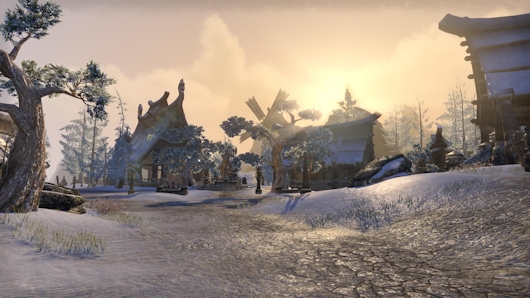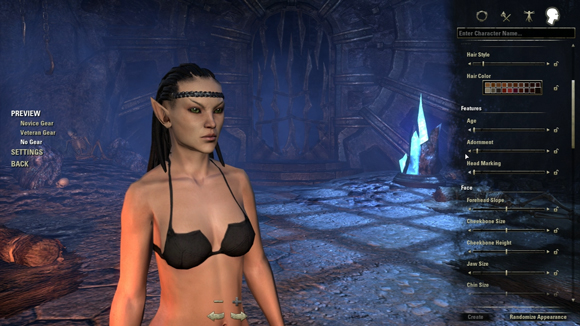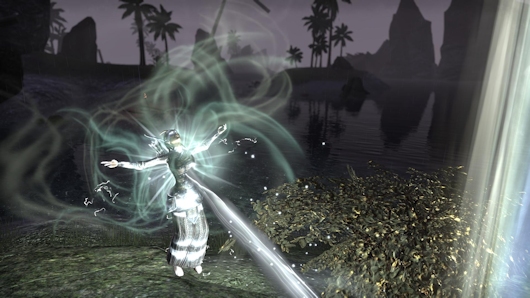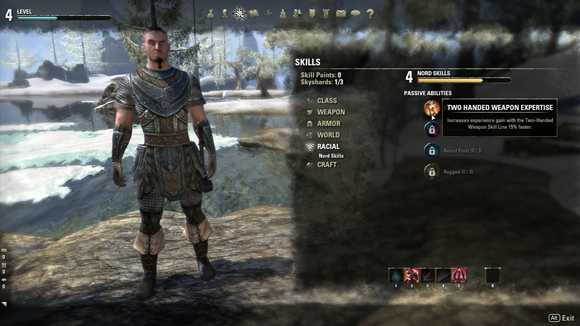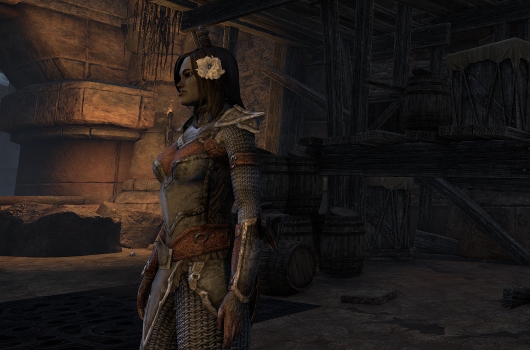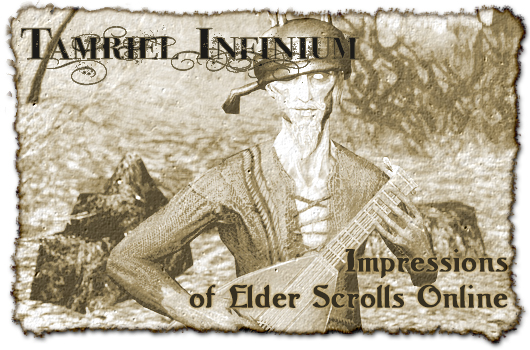A guide to skill progression in The Elder Scrolls Online
In any roleplaying game, a character's identity is largely defined by his abilities, and The Elder Scrolls Online is no exception. During their adventures in Tamriel, players will develop their characters in a variety of ways, including acquiring fancy new gear, but the core progression in ESO is found in its skill advancement system.
Many players of modern MMOs might be inclined to think of a character's abilities as being determined by that character's class, and that is indeed somewhat the case in ESO. However, ESO owes its genesis to a series of games renowned for its freedom of character development, and that legacy continues (albeit to a slightly lesser extent) in ESO's skill progression system, though it also takes ample cues from its contemporary MMOs as well.
Before I delve into the nitty-gritty of skills and progression, I think it's important to explain how skills are used in ESO. At any given time, players have access to a six-slot hotbar (bound to the 1-6 keys by default) onto which players can place five "standard" abilities –- generally a character's often-used bread-and-butter skills -– and one "ultimate" ability, which can be used only after a player has built up enough "ultimate power," we'll call it, which is generated through combat. These ultimate abilities tend to be spectacularly powerful, as you might expect from something with the word "ultimate" in its name.
So how are skills acquired, and how do they progress? Well, let's start with acquisition. Purchasing a skill requires players to spend a skill point, which can be acquired in a few different ways. Characters are granted a single skill point upon leveling up, which will likely provide the bulk of a character's skill points as he progresses. Additional skill points can be earned by collecting skyshards scattered throughout the world (one skill point per three skyshards found) and by completing certain quests.
When spending a skill point, players can choose to acquire a new skill from one of their available skill lines or to morph an already-acquired skill that has leveled up sufficiently to be eligible for morphing. "Skill lines? Morphing? Abilities that level up!? You're talking crazy!" you may be shouting in bewilderment if you're a melodramatic thespian. Let me explain.
First, a skill line is pretty much exactly what it sounds like. Much like in previous Elder Scrolls titles, you can earn levels in various different skill categories, such as two-handed weapons, heavy armor, shield use, and so forth. In ESO, you do this by using said skills. You start at first level in all skills, and at that level, only the first ability in the skill line is available for purchase. However, as you purchase and use abilities from that skill line, you'll gain levels in it, thereby unlocking new abilities in that line for purchase. Some skill lines grant active abilities, some grant passive abilities, and some grant a mixture of both.

Which skill lines a character has access to is determined by a number of different factors, the most important of which is probably class. Each of the four classes has three distinct skill lines available to it, and these skill lines consist of the class's "signature" abilities, including both active and passive varieties. The class skill lines are where Nightblades will learn to turn invisible and stab things in the back, where Sorcerers will pick up their magic missiles and occult familiars, and where Dragon Knights will get that awesome Scorpion-style chain-hook thing, which is all that really matters. The class trees also contain most (perhaps all -- I'm not certain) of a character's possible ultimate abilities, with one ultimate ability available in each class skill tree, so there are at least a few options from which to choose.
Each character also has access to a line of passive skills based on said character's race. High Elves get skills that represent the Altmer aptitude for magic, while Khajiit passives play off of the race's feline grace. These are generally fairly minor bonuses, but every little bit helps, right?
On top of class and race skill lines, there's also a skill line devoted to each of the six fighting styles (two-handed, dual-wielding, one-hand-and-shield, bow, destruction staff, and restoration staff) and each of the three armor types (light, medium, and heavy), with the weapon skill lines offering a selection of active and passive abilities and the armor lines each containing a single active ability and a number of passive ones.
The weapon and armor skills play an important part in ESO's allowing characters to perform roles that they might not traditionally fill. Maybe you're a Sorcerer who's tired of waving a stick around in a tacky robe; instead, you want to lead the charge and wade into the morass of the front lines. Well, slap on some plated mail and a greatsword, level up your heavy armor and two-handed skills, pick up some abilities, and voila: You're a battlemage.
But maybe class, race, weapon, and armor skill lines (that's 13 skill lines total, for those keeping score at home) aren't enough for you. Don't worry; players can also unlock entirely new skill lines as they progress through the game. Joining the Fighters Guild or Mages Guild, for instance, unlocks a new skill line associated with the guild. As players advance within a guild, more abilities in that guild's skill line will become available for purchase. There's also a skill tree associated with each of the game's many tradeskills, such as Enchanting and Blacksmithing, and these trees simply provide a number of passive skills that enhance a character's proficiency within that profession.
So now that we know what skill lines are and how they work, let's talk a little bit about progression within a skill line and the skill morphing mechanic. As mentioned, as you unlock and use abilities from a given skill tree, it's possible for your level in that skill to increase. But on top of that, the abilities themselves can also level up, and when an ability reaches a high enough level, you can pay a skill point to morph that ability into a new-and-improved version.
For instance, my Nightshade had an ability that was a fairly straightforward damage-dealing melee attack. When it had leveled up enough, however, I was given the choice between morphing it into one of two new abilities. The first option would allow the attack to be used at range, while the other would cause the ability to heal me if I killed an enemy with it. Each ability has two morph options, which should allow players customization not only in their choices of skill lines but in their ability morphs as well.
Ultimately, each character has access to a number of different skill lines, and acquiring and using abilities from those skill lines allows them to increase their level in that line, thereby allowing new abilities to be purchased. Once an ability has been purchased, it can also level up and eventually be morphed into an improved form of said ability. If you want to know more about skills and character progression and the skill system in The Elder Scrolls Online, just drop me a line in the comments and I'll do what I can!
Don't miss the rest of Massively's Elder Scrolls Online media NDA lift coverage!


